Jordan Wright
December 16, 2013
Dozens of fascinating and inspiring cookbooks have landed on our desks this year. Some from new writers, others from established authors, all eager to bring you into their kitchens and bars to tantalize you with recipes both retro and re-imagined. I’ve tried to pick out a few that are not on everyone’s radar. Here are a few that caught my eye…and my palate.
In Great Pub Food: Make Home Your New Local by Rachel Lane (Hardie Grant, London, 2013) the title says it all. In this nifty book Lane brings over 80 recipes of old school pub fare like Tandoori Chicken Burgers, Beef and Guinness Pie, Cornish Pasties and Rabbit Cacciatore into the home kitchen. Her desserts are comfort food for Brits and the Anglophiles amongst us. Two of my favorites are Eton Mess, a dessert that piles on heaps of heavy cream and strawberries, and Chocolate Stout Pudding that uses as an ingredient the creamy head from a glass of stout. Cozy up to this book before the first snow falls.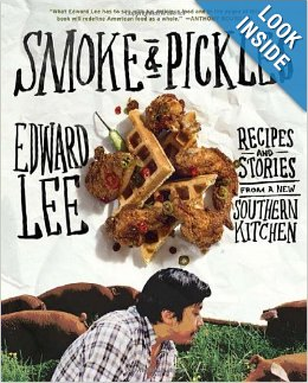
Edward Lee is a celebrated Korean chef who has been in Kentucky long enough to reinvent Southern cuisine. In Smoke & Pickles – Recipes and Stories from a New Southern Kitchen (Artisan Books, 2013) he has brought his Korean cooking techniques to bear on classic down-home cooking.
A three-time James Beard Foundation Award finalist for Best Chef: Southeast he has been perfecting his recipes at 610 Magnolia and MilkWood, his two successful restaurants in Louisville, Kentucky, a city he has called home for the past ten years. In this book he teaches you many of his tricks of the trade – – like how to make your own smoker on the cheap, and how to cure lamb for bacon. To warm the cockles of your heart, you’ll want to try his Asian-style ribs with kimchee and his Braised Brisket with Bourbon-Peach Glaze. While the Whiskey-Ginger Cake with Pear Salad is in the oven, you could be making his Pickled Chai Grapes. Stories of his Korean-American life in Brooklyn, New York add interest to the more than eighty recipes. According to Lee, “I am hoping to capture the inspirational journey of my life and cooking, even as I struggle to remember last night’s cooking.”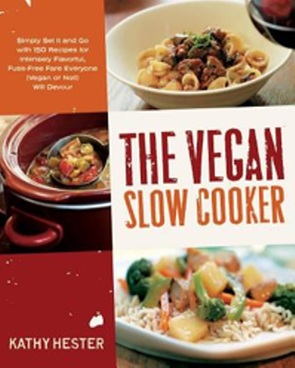
Vegans will want to get in on Vegan Slow Cooking by Kathy Hester (Fair Winds Press 2013). With over 100 recipes geared to a smaller-sized 1.5- to 2-quart slow cooker (crockpot) it’s a fantastic way to have something hot and hearty waiting for you at the end of a long day. I’m eager to try the Root Veggie Barley Risotto, Green Beans in Black Bean Sauce with Tofu, or the Bananas Foster for Breakfast – – a dish that cooks overnight. Perfect for Sunday brunch in bed!
There are delicious-sounding soups like White Bean Barley Soup and Creamy Celery Root Soup. There’s even a fondue made with almonds and Great Northern beans. Hester includes recipes for Cashew Cream, a great substitute for soy-free sour cream, and a budget-friendly chapter for DIY spice blends. Did you know you could bake in your slow cooker? Hester does, making brownies and even an Apple Chocolate Chip Nut Bread Pudding! Now if everyone would eat vegan just one day a week…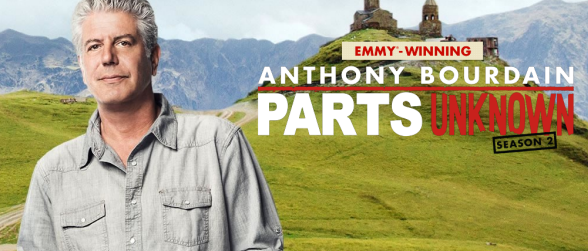
You may have caught the CNN series Anthony Bourdain Parts Unknown, in which our hero teams up with local guides to explore some of the world’s most exotic locales. The episode that most delighted me was the one on Sicily, an autonomous country smack dab in the middle of the Mediterranean. Many times conquered, and thus culinarily influenced by Greece, Italy, North Africa, Turkey and France, it is a wind-swept landscape of farmers and fishermen.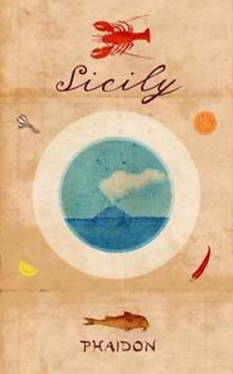
If you’ve ever been captivated by this rugged region…its beauty, its volcanic soil, its hearty foods and its equally hearty wines, pick up a copy of Sicily (Phaidon, 2013) and transport yourself to its charms. This wonderful book tells the history of the island with nature-inspired photographs and authentic recipes from the nine widely diverse regions of the island – – Siracusa, Palermo, Messina, Enna, Racusa, Catania, Trapani, Caltanisetta and Agrigento.
Most dishes reflect the simplicity of the ingredients and the casual style of preparation from Sicilian pizza, Sfincione, and Timballo, the region’s signature layered pasta dish, to Maltagliati con L’Aggrassatu, a flat pasta with a buttery, cheesy, veal sauce. Each chapter begins with a beautiful story giving recipes that employ regional indigenous products.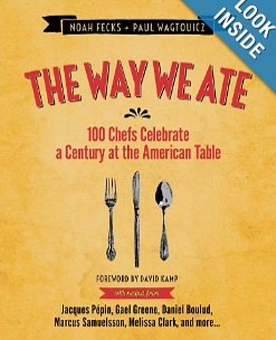
In The Way We Ate: 100 Chefs Celebrate a Century at the American Table (Touchstone, 2013) we can virtually sit at table with today’s most renowned chefs, restaurateurs and food writers (and a singer) from Jacques Pepin, Daniel Boulud and Anita Lo to Chef/Owner Michael Lomonaco of New York’s iconic Windows on the World, Chez Panisse founder Jeremiah Tower and Shanna Pacifico of Back Forty and Back Forty West in Soho. Celebrated food photographers and The Way We Ate Tumblr bloggers, Noah Fecks and Paul Wagtouicz, have created an extravagantly illustrated cookbook chronicling the rich culinary history of the last American century. Here’s the twist. Each chef and food writer has developed an original recipe inspired by a specific year in history from 1901 to 2000.
Local chef extraordinaire José Andrés has dreamed up a re-do of Beijing Glass Noodles, while award-winning chef and cookbook author Jasper White takes a turn at updating Old-Fashioned Cod Cakes. These are super chef-driven recipes, simply described and with beautiful photographs. The first one I’ll prepare will be singer Kelly Hogan’s Breaded Pork Chops with Tart Cherry Caraway Port Wine Sauce. Now where did I stash that bottle of port?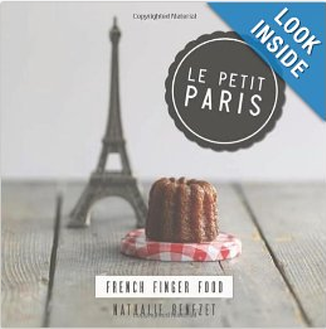
It’s always a good time to throw a party, but in Le Petit Paris: French Finger Food (Hardie Grant, 2013) Nathalie Benezet shows you how to do it the Parisian way. From Croque Monsieur to Foie Gras Burgers and Camembert Fondue, this adorable book offers chic ideas for any hostess or picnicker. I particularly like the petite Salade Nicoise in tiny butter lettuce cups for stylish tailgating, and the easy-to-make Grand Marnier Truffles.
For the hipster on your list, you can’t go wrong with Lust for Leaf: Veggie Crowd-Pleasers to Fuel Your Picnics, Potlucks and Ragers (Da Capo 2013) by Alex Brown and Evan George, a.k.a. Hot Knives. That I don’t know what a “rager” is I’m sure speaks volumes, but no matter, the book is great fun and inspirational in the bargain. The two gonzo journalists and California denizens have made their mark by partying with their friends and sharing the photos of their outdoor cooking adventures. I really enjoyed this book, though it took me longer to type out the title than to flip through it, but not so long I couldn’t get a sense that these two wild and crazy guys are as serious about their bourbon as they are about their BBQ, beer pairings and musical suggestions. Can you make Kale Slaw while drinking Lagunitas beer and digging “Raw Ramp” by T. Rex”? They’d like you to try. Peanut Butter, Banana & Pickle Power Bars? Maybe not. But if I’m drinking the suggested Stone beer and listening to “Clay Stones” by We Are the World, well, why not?
How would you like to have access to wholesome fresh greens loaded with protein and nutrients even in the middle of winter? How about right in your own kitchen all year long and for pennies? Then why not make a garden indoors by growing your own sprouts, a fun and inexpensive activity I haven’t revisited since my college days.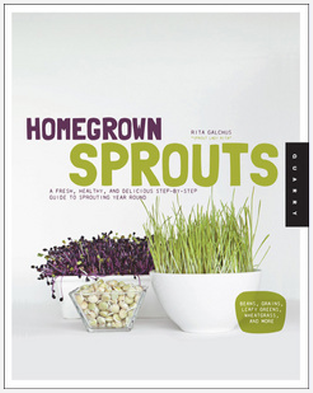
Rita Galchus, author of Homegrown Sprouts (Quarry Books 2013), makes it a snap, to grow your own sprouts explaining three major methods – – from growing them in a Mason jar or using a hemp-sprouting bag or even a sprouting tray specifically made for this simple task. Anyone can do it and kids will get a kick out of growing their own food. A big trend now is chia seed pudding, which I have seen at Le Pain Quotidian and Whole Foods. But why not make your own? It’s a snap.
The book has 200 helpful photographs and ideas for how to incorporate nutrient-rich sprouts into your breads, salads, juices and spreads. You can even share these phyto-packed treats with your pets. Most sprouts only take a few days to pop out of their tiny seeds and provide a super-nutritional food source. Try radish, barley, arugula, rice, flax and sesame, or grow your own snow pea and sunflower shoots used by chefs in some of the best restaurants.
Local and Notable 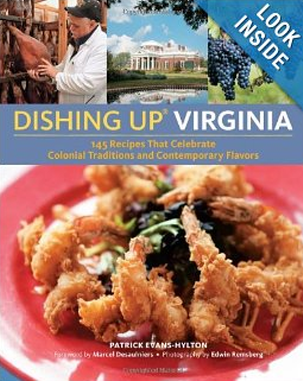
One of Virginia’s most colorful and delightful food and wine writers comes to us from the Hampton Roads and Chesapeake regions. Patrick Evans-Hylton, co-host of NPR’s locally produced show What’s Cooking Wednesday and food reporter for The Hampton Roads Show has written a marvelous compendium of Virginia recipes. It’s called Dishing Up Virginia. Using his extensive knowledge of colonial foods and recipes from some of the Commonwealth’s best chefs, Evans-Hylton has crammed the book with evocative photos from bay to farm. It’s a marvelous collection that belongs on every Southern cook’s shelf. Follow Patrick at www.PatrickEvansHylton.com.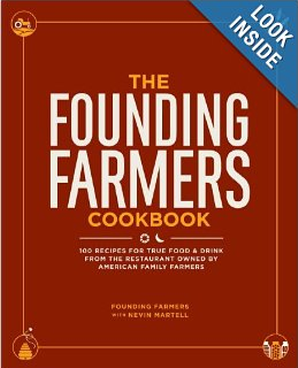
Local food writer and pop culture archaeologist Nevin Martell has teamed up with Farmers Restaurant Group and Executive Chef Joe Goetze to create a cookbook showcasing the recipes from Founding Farmers restaurant. The Founding Farmers Cookbook: 100 Recipes for True Food & Drink from the Restaurant Owned by American Family Farmers (Andrew McMeel Publishing 2013) is a healthful, casual, rustic style of cuisine featuring recipes that use the farm-sourced products incorporated in their seasonal menus. If you’ve ever dined at the DC-based restaurant you’ve most likely swooned over the Seven-Cheese Mac & Cheese Salmon, Crab and Lobster Devil-ish Eggs, or the Many Vegetable Salad with 13 different veggies. Healthy never tasted so heavenly! These recipes and dozens of other well-loved classic dishes are given here. As Founding Farmers co-partner Mike Vucurevitch puts it, “ A lot of dishes were based on my travels throughout America, which have taken me to every state. Sometimes my life feels like that Johnny Cash song “I’ve Been Everywhere”. To catch more of Martell’s adventures in food writing follow him at www.NevinMartell.com.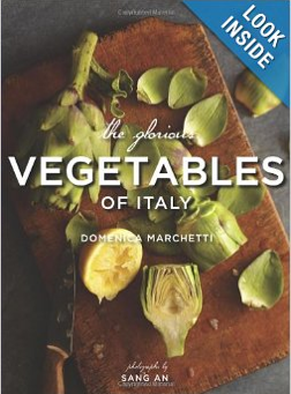
Italian cookbook writer and regular contributor to the Washington Post, Domenica Marchetti, tackles her fifth topic with The Glorious Vegetables of Italy (Chronicle Books 2013). Here veggies get 100 chances to shine. It is a tribute to her Abruzzian mother who taught her to roll pasta as a child that Marchetti is expert in all things from an Italian kitchen, both traditional and modern. The vegetable-centric recipes range from soups to antipasti and main dishes to desserts. Some include meat but not as the featured performer. Grilled Lamb Spiedini on a Bed of Eggplant Caponata, Carrot Polenta Cake with Marsala and Pumpkin Gelato show Marchetti’s versatility in the kitchen. Pizza, calzone, panini and pastas are well represented here too. Exquisite photographs by Sang An highlight the beauty of these soulful dishes.
On January 23rd Marchetti will present a five-course dinner featuring dishes from the cookbook at the National Press Club in DC. Wine pairings are included. For details on the ticketed event visit http://press.org/events/verdure.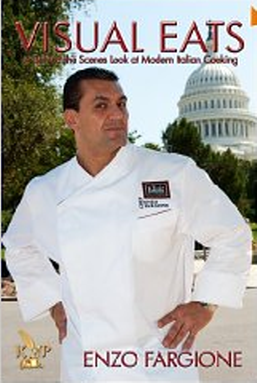
In Visual Eats: A Behind-the-Scenes Look at Modern Italian Cooking (Keith Publications, 2013) renowned DC chef Enzo Fargione shares stories of his upbringing in Turin, Italy alongside insider tales of his restaurant experiences. Known for his culinary sorcery in dishes that stunned the food world when he was at Teatro Goldoni (like the dazzling Four-Minute Smoked Branzino Carpaccio served in a cigar box which your humble scribe has had but once and never forgotten) are here revealed and tailored for the home cook. Now helming the kitchen at his own DC restaurant Osteria Elisir, Fargione aims to reach out and teach the average cook how to be a wizard in the kitchen.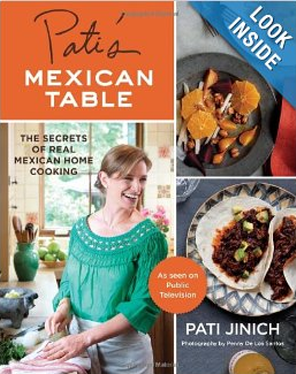
Pati Jinich, Executive Chef at DC’s Mexican Cultural Institute and host of the PBS television series Pati’s Mexican Table: The Secrets of Real Mexican Home Cooking (Houghton, Mifflin, Harcourt, 2013) has written a companion cookbook of recipes from the show. As in her show the petite blonde with the fiery cuisine shows how you can easily create regional Mexican dishes from Veracruz to Michoacan in your own home. Follow her on www.PatisMexicanTable.com.
Cocktail Confessional 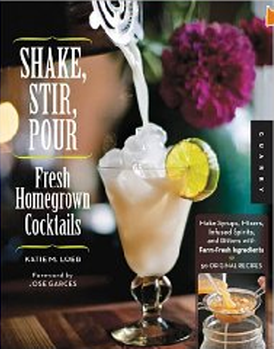
In Shake, Stir, Pour (Quarry Books, 2013) by Philadelphia mixologist Katie M. Loeb you’ll find beverage recipes both with and without the use of spirits. I’m a sucker for any book that tells a story about each concoction and Loeb does. There are more than four dozen nicely photographed recipes that use her basic syrups and infusions. I loved the Rhubarb, Pear and Thai Basil syrups, as well as infusions like Jalapeno-Cilantro Vodka and Limoncello. The book’s foreword is penned by uber-chef and Philly restaurateur, José Garcés, which gives you an idea of the company Loeb keeps.
As a noted bartender, sommelier and creator of craft cocktails who has written for Bon Appetit, the Los Angeles Times and Food & Wine, Loeb will have you making and shaking up a “Gin-Gin Mule” or a “Rosalind Russell”, a throwback cocktail from New York City’s Stork Club Bar Book published in 1946. She even gives a recipe for the Aquavit that’s used in the drink.
December 6, 2013
Cary Pollak for Whisk and Quill
Held at DC’s Walter E. Washington Convention Center, the Metropolitan Cooking and Entertaining Show has seen an annual increase in attendance since Denise Medved first introduced the event in 2001. Featuring a vast selection of products related to both the food and entertainment industries, the show’s success has recently allowed Medved and her Tiny Kitchen, Inc. production company to expand into the Houston and Dallas markets.
Throughout the two-day run attendees enjoy face time with more than 200 local and national vendors, attend “Tasting and Entertaining” workshops, talk to cookbook authors at book signing stations, wander through countless aisles to sample tasty tidbits from some of the finest local restaurants at the “Grand Tasting Pavilion”, shop for gifts at the “Holiday Bazaar” and watch cooking demos on the “Food Lion Cooking Stage”. This year some of the country’s leading chefs gave demonstrations featuring recipes from the National Beef Cook-off Recipe Contest. All these activities were included in the day’s admission charge. Additional ticketed events showcase live culinary performances by celebrity chefs.
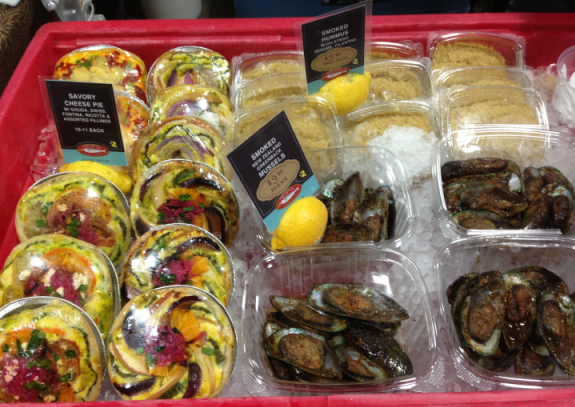 A colorful display of smoked seafood products from the Neopole Smokery of Baltimore, MD and Washington, DC A local luminary who has previously demonstrated at the show is Francois Dionot whose L‘Academie de Cuisine has distinguished itself over the past thirty years as the premier training ground in our area for avocational and professional chefs. Listening to the celebrated chef’s stories about his experiences at well-known restaurants in Europe and the U.S. and about developing the distinguished cooking school, was worth the trip.
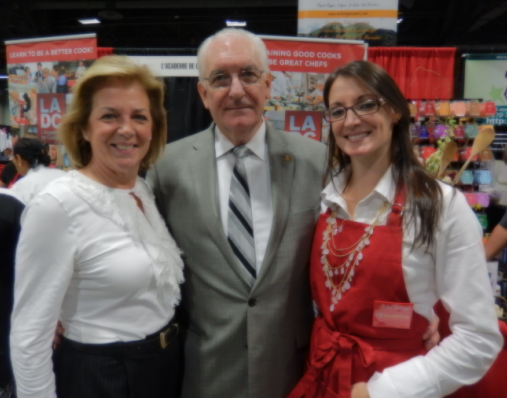 L’Academie de Cuisine founder Francois Dionot, with wife Patrice and daughter Claudine The ever-charming Hugh Acheson, whose easy and friendly manner seemed almost incongruent with the entrepreneurial and culinary skills that have brought him to the top of his profession, was one of the chef demonstrators. Acheson is Chef/Co-owner of the former Five & Ten and The National restaurants in Athens, GA, along with Empire State South restaurant in Atlanta. He is also an occasional judge on Bravo’s Top Chef and holds the honor of being nominated six times for a James Beard Foundation Award. In the past he won “Best Chef Southeast” for his work at Five & Ten. He is the author of the James Beard Foundation Award winning cookbook, “A New Turn in The South”. At this year’s show he dazzled the audience with his version of Frogmore Stew.
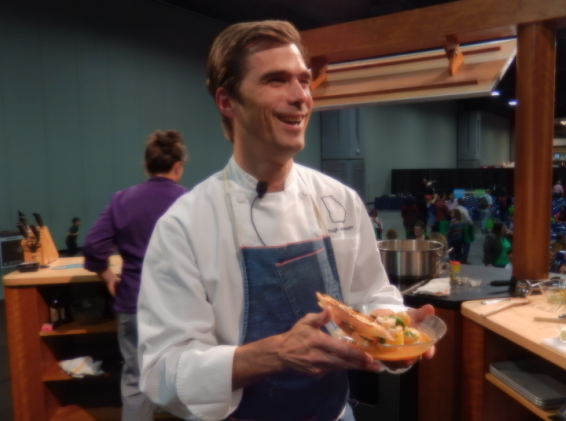 Television chef and restaurant owner Hugh Acheson Joe Yonan, Food and Travel editor at the Washington Post, was also on board. Yonan, who has led his paper’s food writers to two awards by the James Beard Foundation for the nation’s best food section, put his professional chef’s diploma from the Cambridge School of Culinary Arts and journalism degree from the University of Texas to good use by demonstrating a Kale and Mango Nicoise Salad recipe from his recent cookbook, Eat Your Vegetables: Bold Recipes for the Single Cook. He showed us how to massage raw kale leaves so as to soften them for a salad. He pointed out that this technique avoids other harsh methods of softening, such as drenching them in oil and acidic liquids until they wilt.
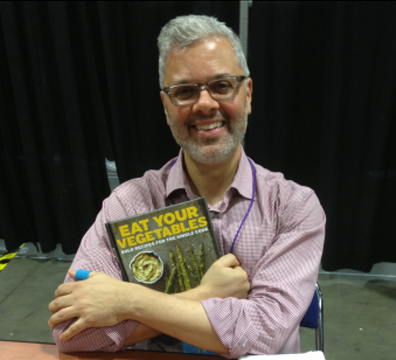 Washington Post Food and Travel editor Joe YonanWashington Post Food and Travel editor Joe Yonan Whether you run into Chef Luigi Diotaiuti at a cooking demo or at his acclaimed DuPont Circle restaurant, Al Tiramisu, you know you will be in for good food and good fun. The affable Italian teamed up with food historian, culinary anthropologist, cookbook author and television personality, Amy Riolo, to make pistachio nut baklava. Off stage onlookers were so close they were asked to participate. We all helped to pile on layers of phyllo dough and watched as the chef drenched the dessert in lemon-infused sugar syrup.
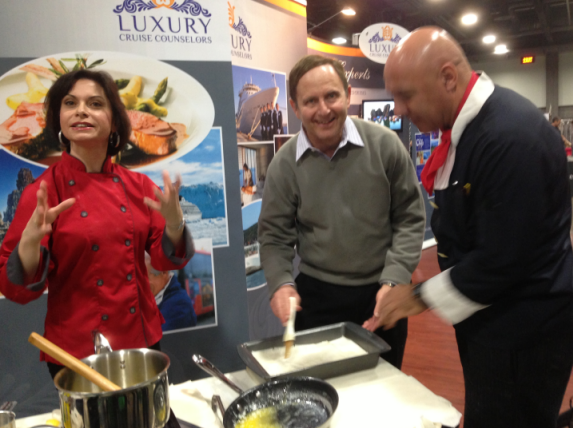 Food Writer Cary Pollak makes baklava with Chefs Amy Riolo and Luigi Diotaiuti Debi Mazar and Gabriele Corcos, the husband and wife team who star on the cooking show, Extra Virgin, on The Cooking Channel, were also at the show. Debi is an American actress who counts the iconic movie Goodfellas among her credits, and Gabriele is a musician from Tuscany. They are both consummate entertainers who love to cook. Together with their young daughter, Giulia, they put on a lively demonstration of Tuscan cooking, preparing seared grouper over Israeli couscous. At one point things got a bit racy when Debi admitted that they argue when they cook. Gabriele agreed that they resolve their disagreements by drinking wine … or by “making kids”. Realizing that the discussion was getting off topic, seven-year old Giulia drew laughs from the audience by asking, “You guys know I’m here, don’t you?”
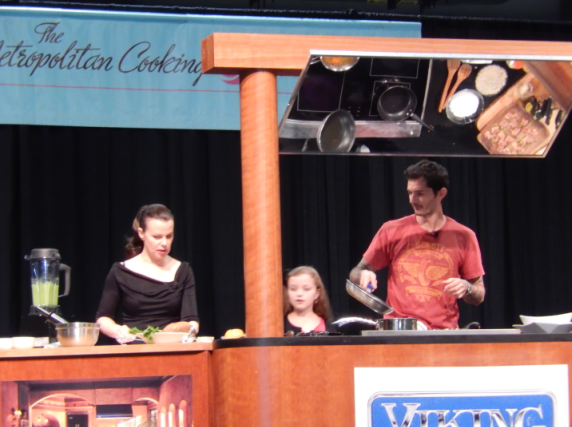 Debi Mazar, Gabriele Corcos and daughter Giulia on the Celebrity Stage The Metropolitan Cooking and Entertaining Show is great family fun for those who enjoy learning more about food and entertaining. There are culinary delights of all types from chatting with vendors and sampling their wares, to meeting cookbook authors, to enjoying cooking demonstrations by notable American-based chefs. Plan on visiting this exciting open-to-the-public show when it returns in the fall of 2014.
Chef Diotaiuti and his partner Amy Riolo are planning a culinary tour beginning in Istanbul and continuing to Athens and the Greek Isles next October 2014. They have graciously consented to share their recipe for Pistachio Baklava with Whisk and Quill’s readers.
Baklava is enjoyed throughout much of the Mediterranean and Middle East thanks to the influence of the expansive Ottoman Empire that ruled much of the region for centuries. This version is most popular in Turkey. During our upcoming culinary cruise from Istanbul to Athens, we’ll experience hands-on phyllo making at Istanbul’s most legendary confectionary shop.
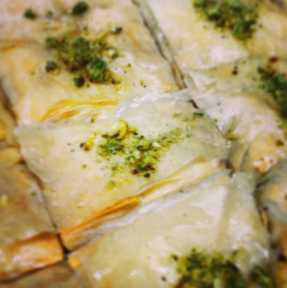 Pistachio baklava
Pistachio Baklava/Fistik Baklava
Recipe by Amy Riolo and Luigi Diotaiuti.
Makes approximately 24 pieces
Ingredients
For the syrup:
3 cups granulated sugar
2 large strips of lemon peel
Juice of 1 small lemon
For the baklava
1 (1 pound) box phyllo dough, thawed according to package directions
1 cup clarified butter
1 pound shelled unsalted pistachios, finely ground
¼ cup granulated sugar
Preparation
- Preheat oven to 350F degrees. Butter a 13×9-inch baking pan.
- Make the syrup by combining sugar, 3 cups water, peel, and juice in a medium saucepan.
- Bring to a boil over medium heat, stirring until sugar dissolves. Discontinue stirring and reduce heat to low. Simmer for 10 minutes and set aside to cool.
- To assemble the baklava, remove phyllo dough from package. Trim it with a sharp knife to fit the pan you are using, if necessary. Wrap excess dough in plastic wrap in the refrigerator. Cover bottom of baking pan with 1 sheet of phyllo dough. Brush clarified butter evenly over the top. Stack another sheet over the top. Brush with more clarified butter. Continue stacking and brushing with butter until half of the phyllo dough is used.
- Combine pistachios with sugar in a medium bowl. Mix well to combine.
- Sprinkle ground pistachio mixture evenly across the top, reserving a few tablespoons for garnish. Continue layering remaining phyllo dough and brushing with clarified butter. Brush top layer with clarified butter.
- Position the pan as if it were a rectangle. With a long, sharp knife, cut phyllo into 6 strips vertical strips across the wide side of the pan(three-quarters of the way down).
- Cut 4 equally spaced vertical lines over the strips (three quarters of the way down) to create 24 squares. Bake for 40 to 50 minutes total, or until golden. Rotate pan every 20 minutes to ensure even browning.
- Remove from oven and drizzle with one ladleful of syrup at a time – allowing syrup to absorb in between ladlefuls. Once baklava has a glistening top and has absorbed syrup, discontinue adding more. Reserve additional syrup for a garnish if serving baklava at a later date. Syrup can be stored in an airtight container in the refrigerator for up to a week.
- Once cooled, sprinkle tops of baklava pieces with a few ground pistachios. Baklava can be covered and stored at room temperature for a day, or in the refrigerator for up to 3 days. Always drizzle with additional syrup before serving.
To find out more about Amy and Luigi’s upcoming tour visit – http://www.yourcruisesource.com/two_chefs_culinary_cruise_-_istanbul_to_athens_greek_isles_cruise.htm.
Photo credits: Cary Pollak
Jordan Wright
December 13, 2012




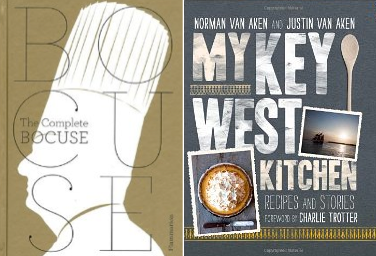
This year’s cookbooks brought us a wealth of ways to be engaged in food in one way or another – grow it, cook it, eat it, share it, broadcast it. While some cover the cuisines of far-off cultures, others focus on a specific region of America or share memories of meaningful meals. Books on preparing a garden’s harvest and instructive manuals on chronicling your food adventures with blogs, photos or Pinterest. Proust would be pleased. Have a madeleine and read on.
Lifestyle Cooking
Each afternoon I am treated to lunch by the writers of the Canal House cooking series – virtually that is. From their bespoke blog they email a beautiful photograph of their luncheon with a short description of how they prepared it and what they served with it. It might come from their Lambertville, New Jersey garden; be foraged on a hike in a nearby woods; or left on their doorstep by a friend. Sometimes a few simple ingredients combined with leftovers from their Sunday suppers or backyard cookouts become a gourmand’s delight. Written by Christopher Hirsheimer, former executive editor and co-founder of Saveur magazine and food and design editor of Metropolitan Home; and Melissa Hamilton, food stylist and former Saveur food editor, Canal House Cooks Every Day (Andrews McMeel Publishing) is a gorgeous collection of over 250 recipes for the home cook.
Entertaining
Cynthia Nims’s Salty Snacks (Ten Speed Press) is a fun book with simple, but original recipes for making your own chips, crisps, crackers, pretzels and other savory bites and had me bookmarking a goodly number of pages. I loved the Cumin Lentil Crackers, Salami Chips with Grainy Mustard, Blue Cheese Straws, Five-Spice Duck Skin, and other tasty treats. Whether you make food for gifting, cater parties or host them, you will refer to this delightful book whenever you’re entertaining. Heads up, family and friends, the Coconut Crisps with Basil and Chiles could be in your Christmas stocking.
How To Books
Helene Dujardin’s Plate to Pixel – Digital Food Photography & Styling (Wiley) shares secrets from her career as a professional food photographer teaching photo-by-photo how to achieve the fabulous results professional food stylists use in creating those mouth-watering photos used in ads, magazines, blogs and books.
Three food-centric books from the “For Dummies” series, give tips for DIYs on how to get your message out with Pinterest For Dummies by Kelby Carr, Food Blogging For Dummies by Kelly Senyei, and Food Styling & Photography by Alison Parks-Whitfield – all from Wiley. Now you can write your own cookbook, blog about your Aunt June’s recipes, or photo broadcast the last scrumptious thing you ate.
Healthful Cooking and Gardening
Health nuts delight! Mark Bittman has you in his culinary sights with Leafy Greens – An A-to-Z Guide to 30 Types of Greens (Wiley). From the New York Times food writer and author of How to Cook Everything, Bittman puts together over 120 recipes to green up your diet. And who isn’t going green these days? Ramp up your anti-oxidant intake with dishes like Bitter Greens with Bacon, Grilled Radicchio and Risotto with Arugula and Shrimp. Whether its mizuna, kale, watercress, broccoli rabe, mustard greens, dandelion or collards, this nifty book will tell you how to identify and prepare over 30 kinds of greens whether found at local farmers markets or an Asian grocery.
I had a lot of fun with Vegan Eats World (Da Capo) by Terry Hope Romero – named “Favorite Cookbook Author” by VegNews. Though I am most assuredly not a candidate for a strict vegan diet, there are many wonderfully creative recipes from a wide variety of cultures that would suit an omnivore. Romero doesn’t just share her recipes and experiences that she describes as “savoring the planet”, she dreams of a vegan revolution. So imagine a tofu banh mi sandwich, a seitan Greek gyro, Jackfruit Tacos, and Korean bulgogi made with extra-firm tofu.
I’m all for growing your own berries and veggies. So over the past ten years or so our family has tended a small plot at the Chinquapin Organic Gardens in Alexandria, Virginia. Community gardening is a great way for urban gardeners to keep their hands in the soil, swap crop tips or recipes, and share summer’s bounty. So I was particularly interested in Fruit Trees in Small Spaces – Abundant Harvests from Your Own Backyard by Colby Eierman (Timber Press) an inspiring and informative book filled with concrete advice on selecting, pruning, espalier training, and preparing the fruits of your labor. Did you know you could make wine from fresh oranges or peach leaves?
Photos by Erin Kunkel who once served as Director of Sustainable Agriculture for the Benziger Family Winery and Director of Gardens at the recently shuttered COPIA: The American Center for Wine, Food and the Arts in Napa Valley, make it look easy and fun. Expect to see his produce on your plate if you are dining at Chez Panisse in Berkeley or Girl and the Fig in Sonoma. As an advocate for children’s gardening programs, he was the co-founder of the School Garden Project in Eugene, Oregon.
Ethnic Cuisine
Phaidon Press, who last year charmed us with the Noma cookbook whose recipes used Scandinavian foraged ingredients, now brings us The Lebanese Kitchen by Salma Hage. Hage has compiled over 500 recipes from every region of her native Lebanon to bring us an astonishing collection of dishes for every course from mezzes to fattoush and aromatic desserts. Within its pinked-edged pages is also a special section devoted to recipes from noted chefs who have already come under the spell of the Lebanese cuisine. Roasted Sea Bass in Tahini Sauce, a Middle Eastern favorite of mine, is here demystified.
Morocco (Chronicle Books) by Jeff Koehler has a subtitle – A Culinary Journey with Recipes from the Spice-Scented Markets of Marrakech to the Date-Filled Oasis of Zagora which pretty much tells you what you can expect from its matte finish pages. If I could eat this book I would. You can almost smell the rosewater and spices. This is why everyone dreams of visiting the ancient North African nation and why those that have come away with stars in their eyes. The food is lavish, sensual and colorful. From tagines to cous cous with a section on the Moroccan pantry that defines the country’s exotic ingredients. It is easy to follow and sublime to eat. You can follow Jeff’s culinary adventures on his website www.jeff-koehler.com.
Also worth noting is Rice & Curry – Sri Lankan Home Cooking (Hippocrene), a re-issue written by former Rolling Stone contributor S. H. (Skiz) Fernando Jr. The photo-laden cookbook slash travelogue, has book jacket blurbs from Andrew Zimmern, host of Bizarre Foods and Anthony Bourdain who used Skiz as a guide through Sri Lanka on Travel Channel’s No Reservations. Visit this link to read about Skiz’s DC pop up dinner this summer and more 2012 cookbook reviews.
American Regional
Get the jump on your Charleston friends this year with Mastering the Art of Southern Cooking (Gibbs Smith). Veteran cookbook authors Nathalie Dupree and Cynthia Graubart explore the history of Southern regional cuisine with recipes that reflect the Old South along with some modern day twists. This summer I watched Ms. Dupree making an unholy mess at a biscuit demonstration at Maryland’s National Harbor. She was as funny on that hot steamy day as she is in this book. And she gave practical tips in the same generous way she shares them on these pages.
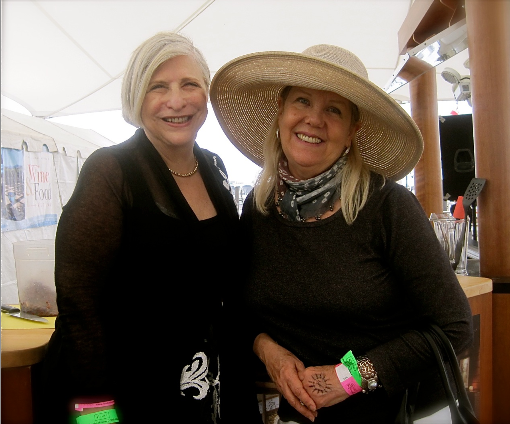 Jordan with Nathalie Dupree “I always use flexible plastic cutting boards. They make life easy when you transfer dry ingredients to the bowl and cut out your biscuits,” she trilled. She went on to show how the biscuits must touch, and how she uses a 9” cake pan to nestle eight biscuits together. “That’s enough for four for the first serving. You can put in another pan after that to keep bringing out hot biscuits.” She is very clear in her instructions and it certainly emboldened me to learn to make the perfect biscuit. In this terrific compendium of all things edibly Southern you’ll find classics like Fried Chicken, Pimento Cheese and Sweet Potato Biscuits along with Peaches and Figs Wrapped in Country Ham. It’s a keeper – all 600 recipes!
Memoirs
Margrit Mondavi’s Sketchbook – Reflections on Wine, Food, Art, Family, Romance, and Life is a personal favorite. Margrit, widow of Napa wine pioneer Robert Mondavi and worldly octogenarian, has written this book with her heart and soul. It is a refreshingly candid pentimento by a lively spirit who has found both pleasure and passion in both work and life. Enjoy a memoir that reads like a private conversation with a close friend, and is beautifully composed with personal photographs, recipes and tributes from friends and family, and illustrated with her whimsical watercolor studies chronicling the couple’s private dinner menus, tablescapes and plein air landscapes. Visit this link to read my recent interview with Margrit Mondavi. .
Marcus Samuelsson’s latest book, “Yes, Chef”, is an emotion-filled autobiographical journey beginning with his adoption as a child from his native Ethiopia to his new family in Sweden. The James Beard Foundation Award winner and winner of Top Chef Masters has written a thoroughly fascinating and poignant memoir that takes the reader from his culinary education in Europe to his success at New York’s Aquavit restaurant, later culminating in the 2010 opening of his smash hit Red Rooster restaurant in Harlem. Visit this link to read my August interview with Samuelsson at the Howard Theatre.
A Table at Le Cirque: Stories and Recipes from New York’s Most Legendary Restaurant (Rizzoli, NYC) written by its creator the Tuscan-born Sirio Maccioni and Pamela Fiori, a former editor at Town & Country and Travel & Leisure, puts you squarely at the best table in Manhattan. For close to four decades, this exclusive institution has been a glamorous watering hole for celebrities and the country’s social and business elite. Many of the world’s leading chefs have made their mark in its kitchens and the book contains recipes of some of their legendary dishes including Daniel Boulud’s Black Bass with Barolo Sauce, Alain Sailhac’s Fettuccine with White Truffles, Pierre Schaedelin’s deconstructed Caesar Salad, and noted chocolatier Jacques Torres’s Bombolini.
Local and Notable
Jersey born and bred Mike Isabella has a passion for food – earthy, soul-stretching, heart-stirring Italian food – and he’s decided to share it with the home cook. In Crazy Good Italian (Da Capo Press Lifelong Books) he takes you into the kitchen with his nonna to teach you the family’s favorite dishes. Included in the over 150 recipes that speak to his Italian roots is his famous Pepperoni Sauce, the one that wowed the judges on Bravo’s “Top Chef”. Isabella has gotten to be a familiar fixture not only on television, where he made a cameo appearance on “Life After Top Chef”, but also around the DC area with his casual resto Graffiato and Georgetown venture Bandelero. His almond and jam flavored Rainbow cookies are perfect for Christmas with their red, gold and green layers topped with chocolate. Visit this link to read my piece on Isabella’s opening of Bandelero earlier this year.
My first assignment as a DC-based food writer was to interview Carla Hall at DC’s CulinAerie, a catering company where she once taught cooking classes. I found her presiding over a TV watch party with her friends and co-workers, held the night the Top Chef finalists were announced. Though she came in second that night, the show forever changed the life of the former French fashion model in ways she could not have imagined.
Currently the co-host of ABC’s The Chew, Hall has written her first book Cooking With Love – Comfort Food That Hugs You (Simon and Schuster Digital Sales). In it she offers up her versions of simple, home-style dishes like Chicken Pot Pie and Deviled Eggs with Smoky Bacon. The amorous title best describes Hall’s easygoing approach to cooking. She continues her presence in DC as executive chef of Alchemy, an artisanal cookie company. Visit this link to read my interview with Hall on that auspicious night.
A Few More Treasures from This Year
Bouchon Bakery (Artisan) by Thomas Keller; Jerusalem: A Cookbook (Ten Speed Press) by Yottam Ottolenghi and Sami Tamimi; My Key West Kitchen: Recipes and Stories (Kyle Books, London) by Norman Van Aken and Justin Van Aken; The Complete Recipes (Flammarion, Paris) by Paul Bocuse.
Jordan Wright
August 7, 2012
Special to Washington Life
 Top Chef Master Marcus Samuelsson at the Howard Theatre, Washington, DC – photo credit Jordan Wright A child is seated on the grass in the Land of the Midnight Sun, his attention drawn downward by a clump of flowers. They are everywhere stretching across the rolling hillside as far as the eye can see, but he is focused on collecting specific elements for a simple bouquet clutched in his tiny left hand. A striped knit cap is pulled down tightly over his head. He is five. He appears curious and self-assured, methodical and intense, traits he evidences in no small measure to this day. The scene is from a black and white photograph out of Marcus Samuelsson’s latest book, “Yes, Chef”, an autobiographical journey that opens with his earliest memories of his adoption from his native Ethiopia. 3,700 miles as the crow flies, to Sweden.
Marcus Samuelsson’s ascendancy to Top Chef Master is no fluke. Hard work, numerous television appearances and a slew of cookbooks have shown a bright light on his skills and restaurants. His unique path to a life in professional kitchens began when he was cut from his small town of Göteborg’s soccer club because of his slight frame. “I sometimes think of myself more as a failed soccer player than an accomplished chef,” he admits.
For a while he knocked around a few local restaurants until landing in Switzerland where he trained under the old European hierarchical system where Larousse Gastronomique and Escoffier’s Le Guide Culinaire were the bibles of French cooking. There he was put to the test in a brutally exhaustive regime fraught with demeaning work, withering insults from head chefs and inhumane hours. The system offered internships to Michelin-starred restaurants where the treatment of young chefs was equally as intense. Samuelsson not only survived, unlike many of his peers, but thrived, learning the intricacies and pitfalls of the business from the inside out and perfecting a disciplined mind that would rival that of an Eastern mystic.
Over the years and throughout his travels Samuelsson kept a diary of his food experiences carefully recording the regional dishes he learned to prepare and daydreaming about how he would do them differently when the time came to open his own restaurant – a time that would come when he could at last merge international flavors with traditional cuisine. That day came in 2011 with the opening of Red Rooster in New York’s Harlem where he has put down roots in the city he has come to call his own.
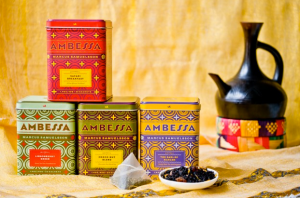 Ambessa Teas Last month I sat down with him in the newly restored Howard Theatre in Washington, DC where he has created the venue’s current menu and where he was preparing to discuss and sign his latest book along with an onstage cooking demo. He kindly brewed me a cup of Choco Nut Blend from his new line of Ambessa specialty teas he has created this year for Harney and Sons.
Jordan Wright – You say in your book that a jazz musician looks for a new kind of perfect as going “deep in the shed”. Does that apply to you?
Marcus Samuelsson – Yes! Well, sometimes. For me perfection can be different things. When I started cooking French food we were serving only about two percent of the population. Now I find perfection in berbere [an Ethiopian spice mix] and the countryside of Ethiopia where I’ve found the smells and flavors that I didn’t know how to value earlier in my life. Perfection can mean different things at different times in your life.
JW – You mention in your book wanting to hang out with Keith Haring and Madonna. Who would you like to hang out with now that you haven’t yet met?
MS – It’s been planned for me to cook for Nelson Mandela and that would be really nice. It just hasn’t worked out yet.
JW – Who are the chefs that you most admire today?
MS – My grandmother, who was not a professional but got me going, Charlie Trotter who embraced me early in my career, and I love what Alice Waters has contributed to American cooking. Also I look up to Daniel Boulud and the so many of the unknown chefs who are not yet recognized for their craft.
JW – Are you working with any new ingredients?
MS – Well, not new. I love discovering the ancient Ethiopian foods and presenting them to a non-Ethiopian crowd. It’s fun to treat things a little bit differently like using the chili-like berbere with chocolate or on popcorn.
JW – Who’s been the greatest influence in your life?
MS – My mom and my dad who always gave me guidance. My grandmother giving love and cooking, my parents for my schooling, and my Ethiopian mother who gave me the ultimate sacrifice by making sure we [Samuelsson’s sister was adopted into the same family] would survive.
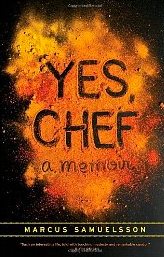
JW – Your book has a powerful message to future chefs that they should be tough, detailed and methodical. Do you think artistry ever trumps hard work?
MS – Cooking is a great craft because it’s a balance between craftsmanship, traditions, storytelling, artistry, finance and marketing. It’s all of those things.
JW – Do you believe that people have an innate talent for cooking?
MS – I’m a firm believer that you have to work on your talent constantly. I’m always traveling and asking myself questions. Talent will get you in the room, but it’s not going to help if you don’t have a good work ethic and curiosity. It’s evolution, evolution, evolution!
JW – Was the White House State Dinner for the Prime Minister of India hosted by the Obamas one of the highlights of your career?
MS – Absolutely! It was a huge honor to be a part of the team on such a big day where so much of the cooking came down to care as well as research.
JW – Let’s talk about your experience on Top Chef Masters.
MS – I learned so much from being with Susan Feniger and Jonathan Waxman, friends that I so much admire, American chefs that came from California and were part of a cuisine revolution that we didn’t have in Europe. What’s great about the show was sitting around before the filming and listening to how they started in a truck back in the 70’s with no money. It was very inspirational. I remember moments that were not caught on tape like when my back went out and Susur Lee was giving me a massage because I could not move. There was such a camaraderie there that you cannot describe.
JW – Do you want to talk about the menu you’ve created for tonight?
MS – It’s really a fun menu. I will celebrate Sweden with its gravlax, go into Harlem with the fried chicken, and then there’s a hash that features Ethiopian flavors, finishing with the chocolate pancake with roasted cherries and blueberries. It’s comfort food and all the things that speak home to me. I’m really excited to be here in the historic Howard Theatre and to witness the resurgence of the neighborhood.
This interview was conducted, condensed and edited by Jordan Wright.
Jordan Wright
March 10, 2012
Special to Indian Country Today Magazine
 The Thirteenth Step by Robert Hayward - photo credit Mark Chambers By the time author Robert Hayward (Winnebago) decided to write about his journey to redemption in The Thirteenth Step – One Man’s Odyssey of Recovery, he had been through hell and back. His resume read like a psych report – drug dealer, addict and full-blown alcoholic. After 26 years of self-destruction his physical health had suffered, his mind had deteriorated, and his relationships with his parents, wife and three kids were on a fast track to nowhere.
What makes this revelatory book so compelling is Hayward’s honesty and heartfelt sincerity coupled with his admission of failure and his decision to turn to tribal wisdom to heal. It is an intriguing insight into the Native American Church’s peyote cleansing rituals yet a cautionary tale to all substance abusers. Though the Church’s practice of using peyote as a sacred sacrament in its ceremonies is perfectly legal for tribal members [under the American Indian Religious Freedom Act Amendments of 1994], it is still controversial and fraught with negative connotations since the 1960’s when it was used experimentally by the counter culture.
To this day there are very few members permitted to conduct this sacred religious ritual and they are referred to as ‘Roadmen’. During the lengthy, ritualistic event, Hayward experienced powerful revelations. Eventually with the trust and guidance of the church’s leaders he was granted permission to reveal the ceremony to the outside world and give his profoundly personal account.
Interview with Robert Hayward
Jordan Wright – You seem to have emerged from a nightmare of alcoholism and drug addiction like a phoenix rising from the ashes. What have been the rewards?
Robert Hayward – I started out using at age 14, so for 26 years I was in a daze. Yet immediately after walking out of that tipi my life has been clear. From then on I have been alive.
I knew I was reaching rock bottom. I remember fishing with my sons and I was in a fog. I was looking at them and had an out of body experience like, ‘I’m not participating. I’m just a drunken mess.’ But now I have clarity, plus I developed a compassion for people that have the same problem. I wanted to reach out and help and that’s why I went back to school to study to become a counselor. It really reinforced my need to prevent other people from falling into the same trap.
JW – Why didn’t you succumb to any of the dangers associated with drug and alcohol use?
RH – I was never arrested because I was selling to the cops and I knew when busts were going down. But there was always danger. And the fact that I’m alive is amazing since I’ve been to over 200 funerals over the years and most were related to alcohol or drugs. Most of the people I grew up with are either dead or in jail or still on drugs or alcohol.
JW – It seems almost like a cult of tragedy.
RH – Yes, in a way we loved the drama. We lived for it. It was like – who could be the most distraught.
JW – Do you think there is another way to reach young people or addicts without the use of peyote in a healing ceremony? And as you go forward as a counselor how you think your ways will be most effective?
RH – My primary focus will be the treatment of Native Americans. But on the other hand I still counsel as a volunteer at A Better Tomorrow, a treatment center here, and of course I don’t use peyote there. Basically alcohol addiction is universally a spiritual problem and it only has a spiritual solution. If you look at the twelve-step program, the third step is the key. And I tell people if you can’t take the first two steps of the program, don’t waste your time with the rest of the steps. You have to turn your will and your life over to God as you understand him – you have to have a higher power. And that really is the key and how you go about that is a personal thing.
No matter what race people are, they have indigenous roots and people respond well to simple things like a campfire at night. I’ll take a group of young people and we’ll talk in a circle and it’s a type of spirituality. It has a calming effect. I’ll put the cedar in the fire and bless them with the feathers and we talk using the same rules as the tipi. They open up and talk, as opposed to sitting in a treatment room where they tell you, “You have 45 minutes to spill your guts.” Even a group of strangers will bond. I think the key is to create a bond. We also pass around water to get the four elements going. Once you have shared a night together in a ceremony, you become a relative to everyone there – no longer separated by blood, but bonded by the spirit.
The trend is to turn towards a chemical short-term solution to get the addict through the early stages of abstinence so that they have a better chance at avoiding relapse. The problem is that there’s a 96% or 97% failure rate in the recovery field and which creates a revolving door in some of these treatment centers that charge up to $30,000 per month, so they’re not super anxious to fix it because people keep coming back and the insurance companies keep paying for it. If they can get three cycles out of each person they’re not real motivated for success.
JW – Can you talk about your interest in starting national programs to help addicts?
RH – I’ll work with John Halpern, MD [Associate Professor of Psychiatry, Harvard Medical School and Director of the Laboratory for Integrative Psychiatry, Alcohol and Drug Abuse Research Center] for who is looking for grants for programs for Native Americans.
The model would be to have an area on a reservation with four tipis and separate the sexes. We’d take the hardcore repeaters for the first night and run them through the ceremony – though it’s critical they go through chemical detox first. Then we would have a ceremony for everyone with members of the Native American Church in order to make a complete circle. What you do in a month in a treatment center, you can do in one night in a tipi. This will speed up their recovery and open up their heart. They would live without cell phones or TVs and we’d have drumming and songs and eating outside. Ideally we would have horses too. What I really want to see from this program is real success. I want to see people not identifying themselves as an addict, which I see as incredibly negative affirmation.
What we have in the Native American Church is a support system for Indian people because it becomes a lifestyle. The social aspects are incredible after we go through the ceremonial night – the bonding is incredible. And then the next morning we become as relatives. It has a lasting bond that becomes our identities. The spiritual aspect is important as well. They have to get a sustainable program going whatever group or church they’re in. I want to start a system that is positive for people – to talk about things that are better. There is a huge demand for that.
JW – Can you talk about the importance of spiritual education from our elders?
RH – That was one of the things that really struck me in that ceremony because the way it works is that ‘The Roadman’ runs it and also speaks throughout the night and different people will talk as the medicine leads you. He will give elder wisdom during the night. There is a huge value to it.
When I counsel kids I ask them what is your real tribal name and clan and then I send them to their elders to talk to them. A lot of these guys think the idea of being Indian is hanging a feather on the rearview mirror of their truck. They don’t even know anything about their family or their tribe, so they lost that identity which then becomes games and alcohol and drugs. Once they sit down and talk to their elders, who are dying to talk to these kids, they come back all excited with stories. It totally changes the way they look at themselves.
The elders would teach us and raise us the way we are supposed to be raised. It’s a huge problem that what we do in all of society is put our elders in housing and separate them – let them rot and grow old. But what you can learn from the elders is stuff you can’t get from books or anywhere else. Unfortunately what you see now is that kids have no respect for elders anymore. And it’s sad. You miss the generational connection without that.
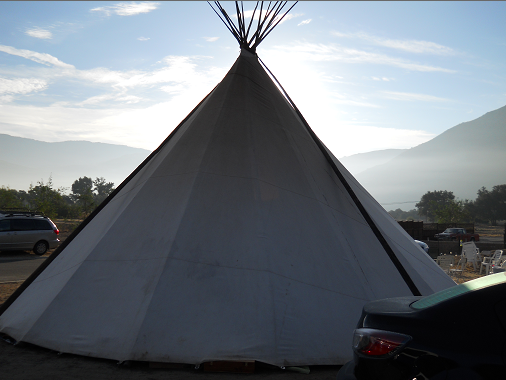 TiPi in Daylight - photo credit Robert Hayward. In tribal groups I talk about the concept of ‘seven generations’. Seven generations ago my ancestors were praying that I would be alive today and that’s the only reason that I am alive. Our duty is to pray for the next seven generations so that there is still clean air and still clean water and still a place to hide in the trees.
We need to keep that continuous cycle so that we don’t just pray for today or tomorrow and live our life that way. The reason that Indian people are having this problem right now is because we are living in the seventh generation since the conquest. So many Indian people were chased off or diseased that they didn’t have the opportunity to pray for this generation, so the circle was broken at that point. We miss those prayers and a lot of the reason we have these problems now is that our ancestors were unable to pray for us.
So there’s this revival about the seventh generation and it’s in all kinds of prophesies that amongst this current generation young kids will rise up and they will they will have dreams and visions and start to bring back the old ways and start reviving the traditions and I’m seeing that, kids that are learning the songs and how to drum at nine years old and you can see the power coming out of them. The best thing that I see happening is the young kids at the pow wows are starting to dress up again and dance and that’s where you see the connection with their elders who are trying to pass this on to the kids. The kids look up to them and that’s where I see the hope.
JW – What has the response been to your talks?
RH – They are really well received, especially when I start off with the video on my website [www.youtube.com/watch?v=IVP-Z6WcYlo] and the crowd will grow, they really get into the story. Nowadays there is a technological separation because of texting, etc. It’s become a novelty to talk to each other. But for me I feed on the energy of the group. I let them know that it’s time we stood up and became accountable. We owe it to our ancestors to get this right. We have to stop this cycle of drinking. Indian people did not drink. There was no such thing as fermented drink. We lack the enzymes to process alcohol or sugar. It ruins our lives – the abuse and everything. People need to hear that there is hope. We need to start giving them something.
I am realizing that the true niche for this book is all Native Americans, because we haven’t had a book written by one of us with our perspective and way of life fully explained in a long time, if ever. It is fast becoming a book that we as Indians can call our own.
We have the opportunity as spiritual caretakers of this land to hear the words of our ancestors because they [the words] are floating in the wind. Their blood is in these rivers and we are part of this earth. Our ancestors are waiting for us to call on them to heal and we have that opportunity. I hear that drumbeat sitting inside the tipi and I get this incredible feeling. We have to reconnect with that ground because it’s ours – it’s all sacred ground. We all have to put more respect back into the earth.
Jordan Wright
December 14, 2011
In no specific order, we read, cooked, gobbled down and swooned over this year’s prolific crop of cookbooks. There were experiential books, back-to-the-farm books, compendiums, (Escoffier was reissued!) and books on baking that hitched their star to the cupcake craze. I chose ones that are unusual and memorable, with an important voice that rose above the din and others that might change the culinary paradigm forever.
Through decades of preparing recipes from the teetering piles of cookbooks in my personal collection, as a former restaurateur and private chef, added to countless hours spent reviewing restaurants, I try to imagine the flavor profile of the combinations of ingredients and techniques in recipes, often without so much as lifting a ladle. I use my culinary imagination, which is forever wired to my palate, reading a recipe for both flaw and flavor – a handy skill for evaluating the complex concoctions presented to a cookbook reviewer.
Winnowed down from the year’s abundant selection of enthusiastic chef/authors (save for a selection written by a scientist who has invented a new field of study called “neurogastronomy” and another marrying technology with kitchen wizardry), I selected nine from a veritable blizzard of tomes chock-a-block with photos luscious enough to make you want to gobble the pages. Four local writers are also featured for their contributions.
Months of bedtime reading were clocked, winnowing out and chucking the ones that are repetitive or recklessly composed. You won’t find those books listed here. On a positive note several books broke new ground and belong on every collector’s shelf.
Below is a list of my favorite cookbooks of the year. None are French. Sacre bleu! One is a re-issue, but deserves revisiting all the same.
 Goat: Meat, Milk, Cheese by Bruce Weinstein and Mark Scarbrough Goat: Meat, Milk, Cheese by Bruce Weinstein and Mark Scarbrough (Stewart, Tabori & Chang)
The authors of this book have penned over 20 cookbooks, including The Ultimate Ice Cream Cookbook so chances are you have at least one in your collection. Weinstein and Scarbrough remind us that not only are goats a sustainable commodity but that they are “the most widely eaten meat across the globe”, though decidedly less in US kitchens.
Riding on the crest of the artisanal goat cheese fad they are positioned perfectly to take us to the next level – how to prepare and serve goat meat. In this latest of their ventures they provide a myriad of recipes (and humorous tales) celebrating goat cheeses and the now readily available goat’s milk. But it is the introduction to the many cuts and uses of goat meat and the rich, deep flavors it brings to roasting, stewing and grilling that are exciting and new.
So strike up a friendship with your nearest halal butcher and try the Braised Goat Meatballs with Artichokes and Fennel, Goat Shanks with Cabbage, Port and Vanilla or the sweet dessert-like Goat Cheese Tamales, a Southwestern treat.
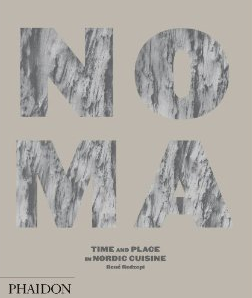 Noma: Time and Place in Nordic Cuisine by René Redzepi Noma: Time and Place in Nordic Cuisine by René Redzepi (Phaidon)
The most exquisitely elegant cocktail table-sized book this year harkens from René Redzepi, whose Copenhagen restaurant, Noma, is now considered the most innovative cuisine in the world, relegating the now-shuttered elBulli, his former employer, to the back burner. Written in diarist style, Redzepi takes us on a “North Atlantic study tour” beginning three months before the opening of Noma in 2003 to the present. We tromp along with the intrepid gastronome through Sweden for lingonberries and Blue Ducks; Denmark for birch sap, rowan shoots and bark; and Greenland for rosenrod, and campanula, a sweet tasting blue flower that grows along the moors and is used for vinegars, marmalades and parfaits. Lavish photos by Ditte Isager .
Whether you will actually cook from this book is not the point, but you will be inspired, as I predict will all chefs worth their sea salt once they crack the spine – tripping over each other to source the exotica – Icelandic moss, spruce shoots and reindeer. This is a love story – a romance of the Nordic land, sky and sea – and an inspiration to the forager inherent in us all.
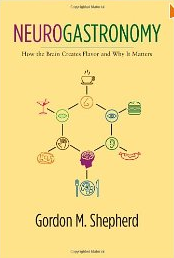 Neurogastronomy – How the Brain Creates Flavor and Why It Matters by Gordon M. Shepherd Neurogastronomy – How the Brain Creates Flavor and Why It Matters by Gordon M. Shepherd (Columbia University Press)
Far be it from me to claim any knowledge of chemistry past the years-ago high school version I took, barely passing the class to the threat, “Here’s a C, now don’t come back!” But in a book on a subject he seems to have invented, neuroscientist, Gordon Shepherd, carves up a well-researched explanation for why Proust so craved the madeleine. Apparently it’s all about “smell and flavor and their relationship to the neural basis of consciousness, ” the Yale professor convincingly claims – all without recipes. If you can follow this weighty topic filled with references to the olfactory cortex, and if combinatorial interactions are in your vocabulary, you are going to have a lot of fun figuring out how to get the kids to eat their veggies and to look back in wonder at what an evocative experience it was. This explanation of the science of flavor and memory might just fire up your receptors and synapses for a swell tour through the laboratory of your sensors!
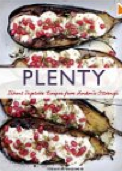 Plenty by Yotam Ottolenghi Plenty by Yotam Ottolenghi (Chronicle Books)
At last this searingly-hot UK chef, whose has four traiteur-style delis and a single sit-down eponymously-named restaurant, has brought his latest book across the pond – thankfully translated from the metric system – to better serve the American cook. Using a casually conceptual approach (chapters are organized by ingredients) he has blessed the reader with his stylishly imaginative approach to cooking. He focuses on one central ingredient, which he then enhances, and as he says “elaborates” on, only to keep the ingredient at the center of the final dish. The sleek line drawn cover belies its ramped-up vegetarian options and scrumptious desserts.
Ottolenghi, who was born in Israel to a German mother and Italian father and writes a column called “New Vegetarian” for Britain’s Guardian Weekend Section, provides many of his most intriguing recipes from his column (along with gorgeous photos from Jonathan Lovekin) like Turkey and Sweet Corn Meatballs with Red Pepper Sauce and Raspberry and Peach Tea Cakes or Sour Cherry Amaretti. For a simple winter weekend dinner try the Caramelized Garlic Tart with Winter Cole Slaw made with apples and celeriac.
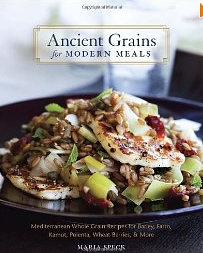 Ancient Grains for Modern Meals: Mediterranean Whole Grain Recipes for Barley, Farro, Kamut, Polenta, Wheat Berries & More by Maria Speck Ancient Grains for Modern Meals: Mediterranean Whole Grain Recipes for Barley, Farro, Kamut, Polenta, Wheat Berries & More by Maria Speck (Ten Speed Press)
As far as I’m concerned there are not enough chefs serving whole grains and pulses. My sense is that they are not perceived to be posh enough ingredients for fine dining. I hope that will change soon and proteins can take a lesser role in high-end restaurants. Along comes Maria Speck who not only triumphs that notion but also offers plenty of recipes to guide you along – Barley Salad with Figs and Tarragon-Lemon Dressing, Leek Salad with Grilled Haloumi Cheese and Rye Berries, Lamb Stew with Wheat Berries in Red Wine Sauce, and Purple Rice Pudding with Rose Water. This whole grain primer belongs on every nutritiously conscious cook’s shelf.
Modernist Cuisine – The Art and Science of Cooking by Nathan Myhrvold, Chris Young, and Maxime Bilet (The Cooking Lab)
Three modern day Escoffiers set out to write the ultimate guide to cooking, replete with the nouvelle vague of high-flying molecular gastronomy acrobatics. It will be eons before there will be anything more comprehensive than this six-volume compendium. Dazzling, iconic and courageous!
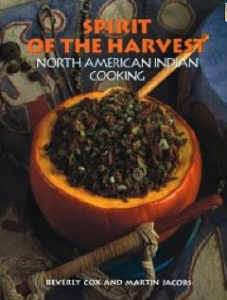 Spirit of the Harvest – North American Indian Cooking by Beverly Cox and Martin Jacobs Spirit of the Harvest – North American Indian Cooking by Beverly Cox and Martin Jacobs (Stewart, Tabori and Chang)
This reissue was a James Beard and IACP award-winner for good reason. It is a well-researched book filled with over 150 traditional recipes from native cultures – Cherokee, Navaho, Comanche, Chippewa, Hopi and many others.
Recipes are accompanied by tribal lore and legends and include uses for indigenous ingredients like cholla cactus, chokecherries and Jerusalem artichokes. Stunning photography by Jacobs incorporates artifacts and objects. Divided into five major US regions, you’ll enjoy preparing Cherokee Pecan Soup and Oneida Sauteed Morels from the Northeast to Olympia Oyster-Potato Cakes from the Northwest. Zuni Corn Soup, a specialty from the Southwest and Pueblo Roast Turkey with Pinon-Raisin Stuffing would be standouts on any holiday table.
FYI: The closest restaurant for sampling regional native cuisine is Mitsitam Café, at the Smithsonian’s National Museum of the American Indian (my all-time favorite lunch spot on the National Mall), serving up regional native cuisine. Their popular Mitsitam Café Cookbook is filled with recipes from the café.
Food Trucks – Dispatches and Recipes from the Best Kitchens on Wheels by Heather Shouse (Ten Speed Press)
A world away from the bastions of fine dining and haute cuisine comes the food truck – now establishing itself as the counterculture’s kitchen-on-wheels for foodies that eschew formal restaurants but love great food. Shouse has been on a countrywide mission to find the “best of” and has done a bang up job uncovering this burgeoning underground food scene. Follow her map and you could be chowing down on some the nation’s most creative gourmet-leaning fast food bites.
Filled with snapshots from the road, the book gives recipes for Winter Squash Soup from Oregon resident and Thai native, Nong Poonsukwattana’s sidewalk cart; Butter Chicken from DC chef Farhad Assari’s Sâuçá truck; and Laurent Katgely’s recipe for Braised Beef Cheeks Sandwich from his gleaming silver truck in San Francisco’s South of Market District. This stuff is big on flavor light on formalities. Use twitter to keep up with these chefs on the move.
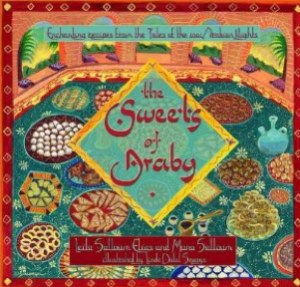 The Sweets of Araby by Leila Salloum Elias and Muny Salloum (Countryman Press) The Sweets of Araby by Leila Salloum Elias and Muny Salloum (Countryman Press)
Channeling the “Tales of the 1001 Arabian Nights” and other medieval texts for inspiration, these Syrian sisters draw back the veil on some of the most delicious and elusively recorded recipes for Arabic sweets. Culled from 10th century Arab culinary manuscripts the authors (who are also professional scholars and historians) tested and tweaked countless recipes to arrive at this exotic and authentic collection, the likes of which have never before been published. With charming brightly colored art by Linda Dalal Sawaya, this beautiful, evocative book of recipes and ancient stories is a treasure as rich and mysterious as the alluring tales from Scheherazade’s lips to her husband King Shahryar’s ears.
Local and Notable
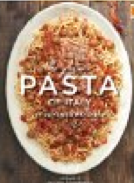 The Glorious Pasta of Italy by Domenica Marchetti The Glorious Pasta of Italy by Domenica Marchetti (Chronicle Books)
Spoiler alert. This writer is partial to the author/chef whose cuisine she has sampled from Marchetti’s own hand.
Rustic and approachable these dishes are bold, elemental and divinely delicious. Not just another Italian cookbook, this is food to impress your guests as well as shine at a potluck supper. Of course, if you bring one of these dishes, be prepared for an onslaught of impending invites. Slow-cooked Pot Roast Papardelle; Maccheroni Alla Chitarra with Ragu All’Abruzzese and Palottine (mini ground veal meatballs); and dishes made for the holidays with sweet pasta dough – La Cicerchiata are tiny fried dough balls held together with honey and decorated with almonds. These recipes highlight the many different styles of cooking in Italy and reveal the author’s passion for her roots.
Serve Yourself by Joe Yonan (Ten Speed Press)
Dinner for one (known in waiter-speak as DFO) has never seemed so appealing as when Yonan presents one of his ratcheted down recipes. This James Beard Award-winning food editor of the Washington Post has found an underserved niche and filled the void with ethnically eclectic recipes that anyone can cook.
Let’s start with dessert, no one does but we all would like to. I am all over the Cardamom-Brown Sugar Snickerdoodles, ditto for the Spicy Coconut Sorbet that uses a dash of tequila. Imagine that in your next margarita! But just try keeping a fellow diner at bay when you tell them you are home alone eating Duck Breast Tacos with Plum Salsa or Fig, Taleggio and Radicchio Pizza that can be made on the flipside of a cast iron pan. There are lots more neat solo tricks and super healthful recipes to glean from this seasoned chef and writer of the delightful “Cooking for One” column.
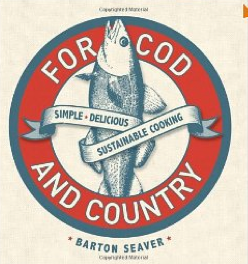 For Cod and Country: Simple. Delicious. Sustainable. by Barton Seaver For Cod and Country: Simple. Delicious. Sustainable. by Barton Seaver (Sterling Epicure)
Barton Seaver is a human lighthouse for the sustainable fishing industry. A former DC area chef, he has taken his mission around the globe earning him recognition and kudos. The National Geographic Society awarded him a fellowship, and he is a sought-after lecturer on topics ranging from sustainability to protecting the environment.
Seaver is well known in Washington for his career as a local chef, working with Jose Andres at Jaleo, Executive Chef of Café Saint-Ex, and later at Bar Pilar. His sustainable seafood restaurant Hook in Georgetown, was named Bon Appétit’s Top 10 Eco-Friendly Restaurants. In one year alone the restaurant had over 75 different species of seafood on its menu. He was named Esquire magazine’s 2009 “Chef of the Year,” and in 2008, was honored as a “Seafood Champion” by the Seafood Choices Alliance and as “Rising Culinary Star of the Year” by the Restaurant Association of Metropolitan Washington.
His first book, organized by seasons (Yes! Most fish have seasons too!), is a collection of recipes based on seafood that hasn’t been overfished or harvested using destructive methods. Seaver shows it can be done with simply prepared and flavorful dishes for the average cook. Grilled Clams with Lemon-Chive Butter, Crab and Corn Toast and Smoked Bluefish Spread are a few of the seafood recipes that beckon. But there are lots of side dish, grains and veggie recipes, perfect for pairing with the seafood.
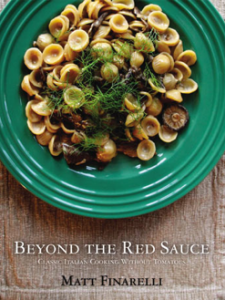 Beyond the Red Sauce – Classic Italian Cooking Without Tomatoes by Matt Finarelli Beyond the Red Sauce – Classic Italian Cooking Without Tomatoes by Matt Finarelli (Self published by www.finarelli.com)
Using a novel approach to Italian cooking, by eliminating the use of one of its most familiar ingredients, this highly personable DC cooking instructor thinks out the proverbial box. Emphatic about his love for the red fruit, he nonetheless challenges the reader with over 100 recipes that skirt around it. That the tomato is primarily a Southern Italian ingredient, still leaves him with a plethora of Northern climes from which to source his recipes. Star dishes include Farfalle with Mascarpone, Asparagus, Hazelnuts and Smoked Salt; Roasted Branzini with Arugula, Prosciutto and Lemon; and a lovely Orange Vanilla Panna Cotta.
Finarelli is a local chef with a huge fan base from the classes he conducts at Sur La Table in Pentagon Row, CulinAerie in DC, Open Table in Falls Church and the Adult Ed programs in Fairfax County. Few cookbook authors spend real time answering basic cooking questions. Even fewer have faced their readers in a kitchen setting. In his young career he estimates he has taught over a thousand budding cooks who he continues to empower and encourage. You won’t find glossy pages filled with alluring photos, but you will be guided by a gentle teacher with a terrific sense of humor whose driving force is sharing his knowledge and experience.
|










































